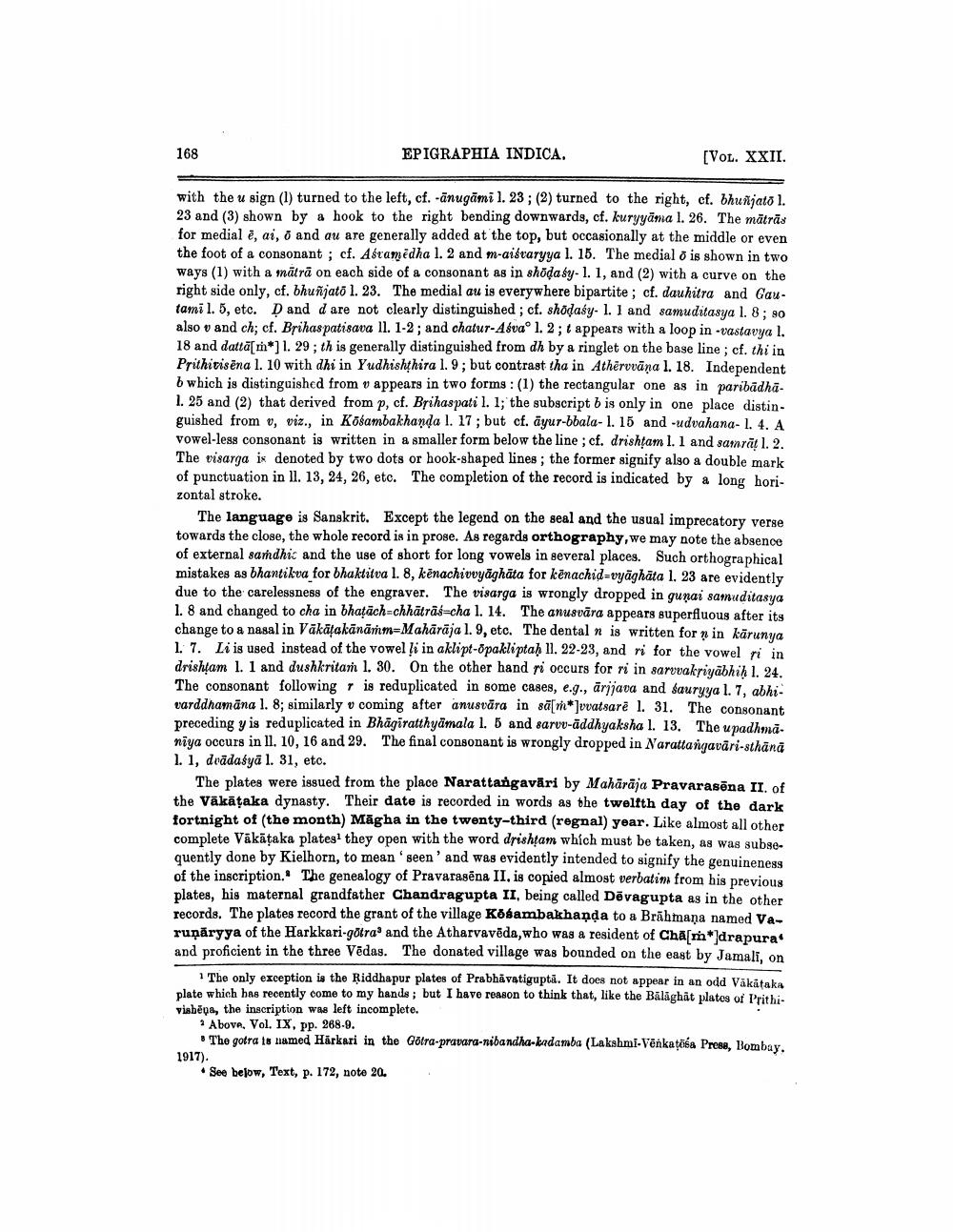________________
168
EPIGRAPHIA INDICA.
[VOL. XXII.
with the u sign (1) turned to the left, cf. -änugāmi 1. 23; (2) turned to the right, cf. bhuñjatō 1. 23 and (3) shown by a hook to the right bending downwards, cf. kuryyäma 1. 26. The mātrās for medial è, ai, ō and au are generally added at the top, but occasionally at the middle or even the foot of a consonant; cf. Asramedha 1. 2 and m-aiśvaryya 1. 15. The medial ō is shown in two ways (1) with a matra on each side of a consonant as in shoḍaśy- 1. 1, and (2) with a curve on the right side only, cf. bhuñjato 1. 23. The medial au is everywhere bipartite; cf. dauhitra and Gautamil. 5, etc. D and d are not clearly distinguished; cf. shoḍaśy- 1. 1 and samuditasya 1. 8; 90 also v and ch; cf. Brihaspatisava 11. 1-2; and chatur-Asva° 1. 2; t appears with a loop in -vastavya 1. 18 and datta[m] 1. 29; th is generally distinguished from dh by a ringlet on the base line; cf. thi in Prithivisena 1. 10 with dhi in Yudhishthira 1. 9; but contrast tha in Athervvāna 1. 18. Independent b which is distinguished from v appears in two forms: (1) the rectangular one as in paribädhä1. 25 and (2) that derived from p, cf. Brihaspati 1. 1; the subscript b is only in one place distinguished from v, viz., in Kosambakhanda 1. 17; but cf. ayur-bbala- 1. 15 and -udvahana- 1. 4. A vowel-less consonant is written in a smaller form below the line; cf. drishtam 1. 1 and samrat 1. 2. The visarga is denoted by two dots or hook-shaped lines; the former signify also a double mark of punctuation in ll. 13, 24, 26, etc. The completion of the record is indicated by a long horizontal stroke.
The language is Sanskrit. Except the legend on the seal and the usual imprecatory verse towards the close, the whole record is in prose. As regards orthography, we may note the absence of external samdhic and the use of short for long vowels in several places. Such orthographical mistakes as bhantikva for bhaktitva 1. 8, kënachivvyāghata for kenachid-vyäghāta 1. 23 are evidently due to the carelessness of the engraver. The visarga is wrongly dropped in gunai samuditasya 1. 8 and changed to cha in bhatach-chhatraś-cha 1. 14. The anusvāra appears superfluous after its change to a nasal in Vākāļakānāṁm-Mahārāja 1. 9, etc. The dental n is written for n in karunya 1. 7. Li is used instead of the vowel li in aklipt-opakliptaḥ 11. 22-23, and ri for the vowel ri in drishtam 1. 1 and dushkritam 1. 30. On the other hand ri occurs for ri in sarvvakriyabhiḥ 1. 24. The consonant following is reduplicated in some cases, e.g., ārjjava and sauryya 1. 7, abhivarddhamana 1. 8; similarly v coming after anusvära in sa[m*]vvatsare 1. 31. The consonant preceding y is reduplicated in Bhagiratthyamala 1. 5 and sarvv-addhyaksha 1. 13. The upadhmaniya occurs in 11. 10, 16 and 29. The final consonant is wrongly dropped in Narattangavāri-sthānā 1. 1, drādaśyā 1. 31, etc.
The plates were issued from the place Narattangaväri by Mahārāja Pravarasēna II. of the Väkäṭaka dynasty. Their date is recorded in words as the twelfth day of the dark fortnight of (the month) Magha in the twenty-third (regnal) year. Like almost all other complete Vākāṭaka plates1 they open with the word drishtam which must be taken, as was subsequently done by Kielhorn, to mean 'seen' and was evidently intended to signify the genuineness of the inscription. The genealogy of Pravarasena II. is copied almost verbatim from his previous plates, his maternal grandfather Chandragupta II, being called Devagupta as in the other records. The plates record the grant of the village Kosambakhaṇḍa to a Brāhmaṇa named Varupäryya of the Harkkari-götra and the Atharvaveda, who was a resident of Cha[m*]drapura' and proficient in the three Vedas. The donated village was bounded on the east by Jamali, on
1 The only exception is the Riddhapur plates of Prabhavatigupta. It does not appear in an odd Väkātaka plate which has recently come to my hands; but I have reason to think that, like the Balaghat plates of Prithivishēna, the inscription was left incomplete.
2 Above, Vol. IX, pp. 268-9.
The gotra is named Härkari in the Gotra-pravara-nibandha-kadamba (Lakshmi-Venkatesa Press, Bombay.
1917).
See below, Text, p. 172, note 20.




